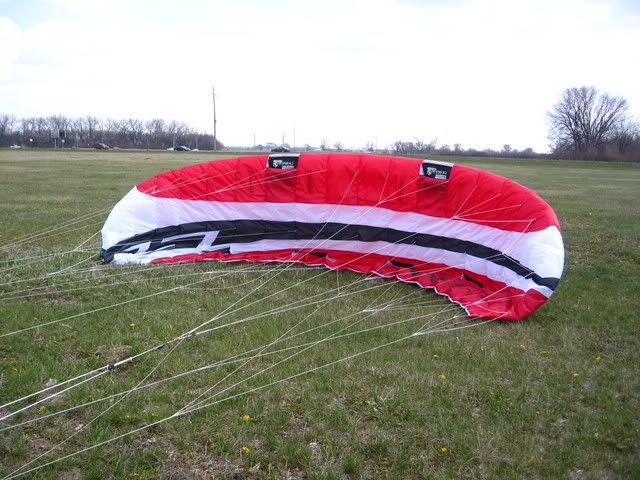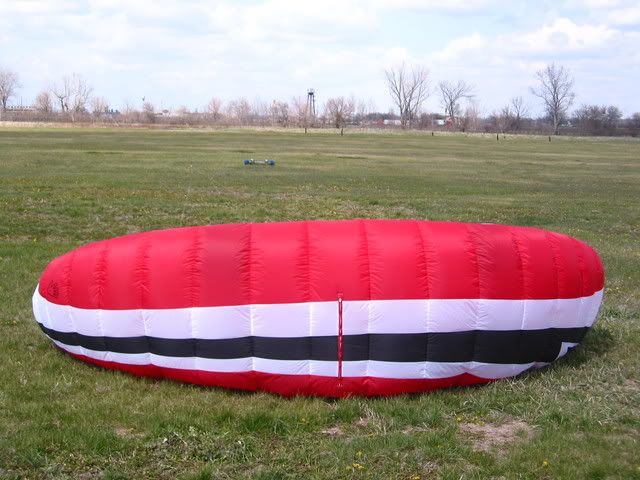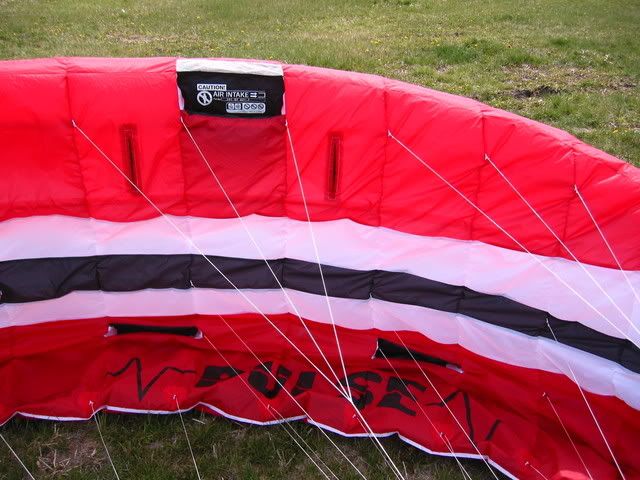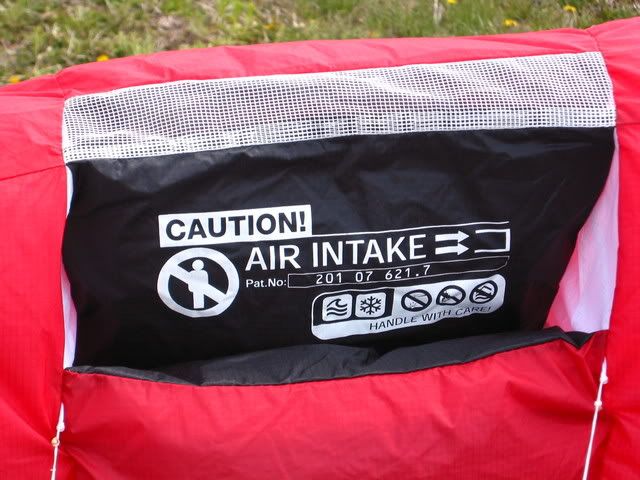
SecondWind - 14-4-2007 at 08:52 PM
I got to fly the 7m Pulse for the first time today. The winds were less than desirable, but the Pulse was very stable and absorbed the gusts well.




I think this would make a great first depowerable for someone - easy to setup, launch, relaunch and fly.
I'll give some more feedback once I get it out in some bigger winds.
Anyone else flying one of these here?
krumly - 14-4-2007 at 11:33 PM
DaVinch -
Not having seen a FS kite up close, what's up with the vents? It looks like the black nylon forms a duct, but then there is gauze/mesh above that
portion. I have a valved VioKite, PL GII, and Quadrifoil Kitesurfer XXL, but none of the valves look close to that.
krumly
Bladerunner - 15-4-2007 at 08:33 AM
Is that international "no Men" sign supposed to tell the ladies something ?
Very nice kite ! With those small inlets and huge depower you should have a real gust muncher there IMHO !
SecondWind - 15-4-2007 at 10:30 AM
Powerzone - Can you give us the scoop on how the Jet Flaps work?
Jet Flaps are a High Lift Device
krumly - 16-4-2007 at 11:31 AM
DaVinch -
Jet Flaps are wing slots that allow the boundary layer to remain attached further back along the top surface of the wing by adding high energy flow
from the bottom of the wing. This means boundary layer separation occurs at a higher angle of attack , so the wing can operate effectively at higher
angles of attack.
I've attached a page from the classic text "Theory of Wing Sections" by Abbot and Von Doenhoff. It illustrates a number of slot and flap combinations
for a "standard" Clark Y airfoil and how they affect maximum lift, lift/drag over the "standard" airfoil.
Interestingly enough, a trailing edge flap makes for a large increase in the maximum coefficient of lift with a very high Cl/Cd, but the section
stalls at a LOWER angle of attack. Mid-chord slots give a higher Cl by allowing HIGHER angles of attack, but the Cl/Cd ration isn't any better than
the standard foil section. Combining the two sort of gives "the best of both worlds."
Also check out http://www.centennialofflight.gov/essay/Theories_of_Flight/D...
krumly

domdino - 16-4-2007 at 02:56 PM
Mmm looks lovely DaVinch...
How do they perform jumps wise? I'd love to get one for high winders, but the main issue i have with most flysurfers is there extreme forward pull and
somewhat lacking upward pull?
Bladerunner - 16-4-2007 at 04:03 PM
Davinch,
Does you Psycho 3 still have the jet flaps ? It didn't look like they did.
Krumly,
I couldn't link to the theory of flight page ? I'll just have to go to College for a couple of years so I can figure out what you said. 
krumly - 16-4-2007 at 07:24 PM
Snowbird -
To save you having to go to college, here's the link again:
http://www.centennialofflight.gov/essay/Theories_of_Flight/D...
Maybe the period at the end of the link in my previous post screws it up.
Basically, when a foil is inclined at a positive angle to the apparent wind, it develops lift in a direction perpendicular to the apparent wind. Drag
is also produced in the direction of the apparent wind. The ratio of lift-to-drag indicates how efficient the foil is (a higher lift-to-drag ratio is
associated with a more efficient foil.
Most foil sections develop positive lift starting somewhere around -2 to +2 degrees, depending on their exact shape. The lift increases linearly per
degree increase in angle of attack up to somewhere around 12-15degrees, after which the airflow around the wing separates dramatically and the wing
stalls and starts to lose lift rapidly. what happens when you oversheet a depower kite.
The jet flaps let air flow from the lower side to the upper side of the kite and help keep the flow on the upper side of the kite near the trailing
edge from separating. This lets the kite reach an even higher angle of attack, amybe 18-20 degrees before the flow separates. Higher angle of attack
with non-separated flow = even more lift, and more "headroom" for controlling the kite in gusts. It looks like mid-section slots like jet flaps (see
the JPG attachment) help reach higher lift values, but don't do anything to make the lift-to-drag ratio any higher, so they don't make the foil reach
closer to windward.
I've oversimplified and omitted greatly, but I hope it kind of makes sense.
krumly
SecondWind - 16-4-2007 at 07:25 PM
Thanks Krumy - it's perfectly clear now :tumble:
I actually do want to learn more about the science behind these machines, so I'll definitely check out the site.
Dom - I've only used the Pulse on land so far. Today the winds were 18 mph and really gusty (up to about 25 mph). The little Pulse was a blast -
plenty of air for me.
However, one jump went really bad when I redirected way too much and did a kiteloop (failed) in the air. I landed and slid on my stomach for a while.
Man that hurtů
Bladerunner - 17-4-2007 at 04:33 PM
Thanks Krumly,
That was very well explained.
I'm still keeping the student loan though ! I wonder if the Gov. will accept kitesurfing lessons as a valued education ! 
krumly - 17-4-2007 at 06:21 PM
Snowbird -
Maybe you could loan me some of that loan so I can buy a Flysurfer...
krumly
SecondWind - 17-4-2007 at 07:57 PM
Sorry I missed your question Snowbird - yes, the P3 does have jet flaps.
Krumly, I'm still not sure why the inlets are designed that way :?:
powerzone - 19-4-2007 at 03:08 PM
DaVinch..... Nice Kite.... I fly a 10m Pulse and think that is super fast and fun, i can only imagine a 7m. what winds have you had it out in ?
35mph ? Gotta keep your hands in very close on that bar to get the same feeling as compared on the P3 kites!! carefull of accidental kiteloops !
Krumly gave a nice description of the technical aspects of the JetFlaps... but in terms of kite flying and how the kite feels while riding:
the kite will rush to the edge of the wind window.... then back off a little bit and settle in at the window edge. without the flaps the kite keeps
trying to fly to the edge and eventually stalls.
they also keep the trailing edge full of air. imagine an eddy current on the topside of the trailing edge, this pushes DOWN on the kite as well as
deflates the trailing edge.....add jet flaps to equalize the pressures at the trailing edge and maintain canopy shape and un-disrupted airflow.
first introduced on the TITAN in 2004
http://www.flysurfer.com/Content/78/?mnid=191
powerzone - 19-4-2007 at 03:16 PM
about the Valves.... there are 2 inlets on each intake. 1 upper (small with mesh) 1 lower (large black intake port.
I believe the little one helps in 2 ways. 1 to seal-off the larger one when kite is not in the air. 2 also helps to pressurize the top skin as the air
rushes into the kite thru the large opening. if there were only the 1 large opening, there would seem to be a vaccuum created at the topside of the
leading edge behind the inlet flap.
Flysurfer thinks of everything !
a little more trivia about FS attention to detail.... inside the the Silver Depowerline is an inner core of 500lb Dyneema so if the main depowerline
breaks, you can still kite home. a little insurance goes a long way.
SecondWind - 19-4-2007 at 06:32 PM
Powerzone - Thanks for the scoop on the valves 
The most I've been out in with the 7m is 30 mph. That was plenty for me on land. The jumps were high and the landings were a bit rough because I
kept redirecting too much.
We get some really good winds here in the Spring 








